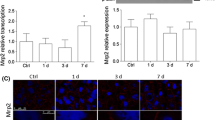Abstract
The mechanism of lithocholate-3-O-glucuronide-induced cholestasis is unknown. In this study, we investigated the cholestatic effects of this agent in a congenital hyperbilirubinemic rat, EHBR. We also studied the effects of ursodeoxycholate-3-O-glucuronide and tauroursodeoxycholate on lithocholate-3-O-glucuronide-induced cholestasis in rats. Lithocholate-3-O-glucuronide, administered at the rate of 0.1 μmol/min/100 g for 40 min, a cholestatic dose in control rats, failed to cause cholestasis in EHBR, and biliary lithocholate-3-O-glucuronide excretion was delayed. Biliary concentrations of this agent did not correlate with the severity of cholestasis. Both tauroursodeoxycholate and ursodeoxycholate-3-O-glucuronide, infused at the rate of 0.2 μmol/min/100 g for 120 min, completely inhibited cholestasis induced by lithocholate-3-O-glucuronide administered at the rate of 0.1 μmol/min/100 g for 40 min. Only tauroursodeoxycholate enhanced biliary lithocholate-3-O-glucuronide excretion. These findings indicate that lithocholate-3-O-glucuronide-induced cholestasis is induced by damage at the level of the bile canalicular membrane. Ursodeoxycholate-3-O-glucuronide inhibits this cholestasis, possibly by inhibiting the access of lithocholate-3-O-glucuronide to the bile canalicular membrane.
Similar content being viewed by others
References
Javitt NB, Emerman S: Effect of sodium taurolithocholate on bile flow and bile acid excretion. J Clin Invest 47:1002–1014, 1968
Miyai K, Mayr WW, Richardson AL: Acute cholestasis induced by lithocholic acid in the rat. A freeze fracture replica and thin selection study. Lab Invest 32:527–535, 1975
Layden TJ, Schwarz J, Boyer JL: Scanning microscopy of the rat liver. Studies of the effect of taurolithocholate and other models of cholestasis. Gastroenterology 68:724–738, 1975
Layden TJ, Boyer JL: Taurolithocholate-induced cholestasis: Taurocholate, but not dehydrocholate reverses cholestasis and bile canalicular membrane injury. Gastroenterology 73:120–128, 1977
Kakis G, Yousef IM: Pathogenesis of lithocholate- and taurolithocholate-induced intrahepatic cholestasis in the rat. Gastroenterology 75:595–607, 1978
Reichen J, Paumgartner G: Inhibition of hepatic Na+, K+-adenosinetriphosphatase in taurolithocholate-induced cholestasis in the rat. Experientia 35:1186–1188, 1979
Yousef IM, Tuchweber B: Effect of lithocholic acid on cholesterol synthesis and transport in the rat liver. Biochim Biophys Acta 796:336–344, 1984
Yousef IM, Tuchweber B, Morazain R, Kugelmass R, Gauvin M, Roy CC, Weber AM: Cholesterol synthesis in the pathogenesis of lithocholic acid-induced cholestasis. Lipids 23:230–233, 1988
Oelberg DG, Chari MV, Little JM, Adcock EW, Lester R: Lithocholate glucuronide is a cholestatic agent. J Clin Invest 73:1507–1514, 1984
Takikawa H, Ohki H, Sano N, Yamanaka M: Cholestasis induced by lithocholate and its glucuronide: Their biliary excretion and metabolism. Biochim Biophys Acta 1081:39–44, 1991
Takikawa H, Tomita J, Takemura T, Yamanaka M: Cytotoxic effect and uptake mechanism by isolated hepatocytes of lithocholate and its glucuronide and sulfate. Biochim Biophys Acta 1091:173–178, 1991
Oelberg DG, Dubinsky WP, Adcock EW, Lester R: Calcium binding by lithocholic acid derivatives. Am J Physiol 247:G112-G115, 1984
Takikawa H, Sano N, Narita T, Yamanaka M: The ursodeoxycholate dose-dependent formation of ursodeoxycholate-glucuronide in the rat and the choleretic potencies. Hepatology 11:743–749, 1990
Takikawa H, Sano N, Narita T, Uchida Y, Yamanaka M, Horie T, Mikami T, Tagaya O: Biliary excretion of bile acid conjugates in a hyperbilirubinemic mutant Sprague-Dawley rat. Hepatology 14:352–360, 1991
Takikawa H, Otsuka H, Beppu T, Seyama Y, Yamakawa T: Quantitative determination of bile acid glucuronide in serum by mass fragmentography. J Biochem 92:985–998, 1982
Goto J, Suzuki K, Nambara T: Synthesis of 3-glucuronide of unconjugated and conjugated bile acids. Chem Pharm Bull 38:1258–1264, 1980
Takikawa H, Sano N, Ohki H, Yamanaka M: Comparison of biliary excretion and metabolism of lithocholate and its sulfate and glucuronide conjugates in rats. Biochim Biophys Acta 1004:147–150, 1989
Takikawa H, Narita T, Sano N, Yamanaka M: Glucuronidation of bile acids by their high dose infusion into rats. Hepatology 13:1222–1228, 1991
Oude Elferink RPJ, De Haan J, Lambert KJ, Hagey LR, Hofmann AF, Jansen PLM: Selective hepatobiliary transport of nordeoxycholate side chain conjugates in mutant rats with a canalicular transport defect. Hepatology 6:861–865, 1989
Kuipers F, Radominska A, Zimniak P, Little JM, Havinga R, Vonk RJ, Lester R: Defective biliary secretion of bile acid 3-O-glucuronides in the rat with hereditary conjugated hyperbilirubinemia. J Lipid Res 30:1835–1845, 1989
Kitamura T, Jansen P, Hardenbrook C, Kamimoto Y, Gatmaitan Z, Arias IM: Defective ATP-dependent bile canalicular transport of organic anions in mutant (TR−) rats with conjugated hyperbilirubinemia. Proc Natl Acad Sci USA 87:3357–3361, 1990
Ishikawa T, Muller M, Klunemann C, Schaub T, Keppler D: ATP-dependent primary active transport of cysteinyl leukotriens across liver canalicular membrane. Role of the ATP-dependent transport system for glutathione S-conjugates. J Biol Chem 265:19279–19286, 1990
Fernandez-Checa JC, Takikawa H, Horie T, Ookhtens M, Kaplowitz N: Canalicular transport of GSH in normal and mutant EHBR rats. J Biol Chem 267:1667–1673, 1992
Kuipers F, Radominska A, Zimniak P, Havinga R, Vonk RJ, Lester R: Defective bile secretion of bile acid-3-O-glucuronides in rats with hereditary conjugated hyperbilirubinemia: Implication for the mechanism of lithocholate-glucuronide induced cholestasis. Gastroenterology 94:A558, 1988
Kitani K, Kanai S: Tauroursodeoxycholate prevents taurocholate-induced cholestasis. Life Sci 30:515–523, 1982
Scholmerich J, Baumgartner U, Miyai K, Gerok W: Tauroursodeoxycholate prevents taurolithocholate-induced cholestasis and toxicity in rat liver. J Hepatol 10:280–283, 1990
Heuman DM, Mills AS, McCall J, Hylemon OB, Pandak M, Vlahcevic ZR: Conjugates of ursodeoxycholate protect against cholestasis and hepatocellular necrosis caused by more hydrophobic bile salts.In vitro studies in the rat. Gastroenterology 100:203–211, 1991
Utili R, Tripodi MF, Adinolfi LE, Gaeta GB, Abernathy CO, Zimmerman HJ: Estradiol-17β-glucuronide (E-17G) cholestasis in perfused rat liver: Fate of E-17G and choleretic responses to bile salts. Hepatology 11:735–742, 1990
Takiakwa H, Sano N, Minagawa K, Yamanaka M: Effect of ursodeoxycholate, its glucuronide and disulfate and β-muricholate on biliary bicarbonate concentration and biliary lipid excretion. J Hepatol 15:77–84, 1992
Author information
Authors and Affiliations
Rights and permissions
About this article
Cite this article
Takikawa, H., Minagawa, K., Sano, N. et al. Lithocholate-3-O-glucuronide-induced cholestasis. Digest Dis Sci 38, 1543–1548 (1993). https://doi.org/10.1007/BF01308618
Received:
Accepted:
Issue Date:
DOI: https://doi.org/10.1007/BF01308618




